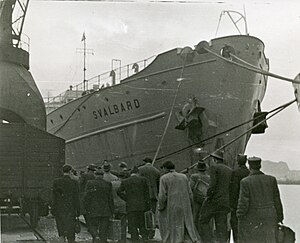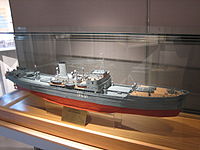German night fighter direction vessel Togo
 Displaced Persons about to board HNoMS Svalbard (ex-Togo) in Genoa, Italy, in December 1948 for resettlement in Australia
| |
| History | |
|---|---|
| Name | Togo |
| Namesake | Togo |
| Operator | Woermann-Linie |
| Builder | Bremer Vulkan, Vegesack |
| Launched | 13 August 1938 |
| Homeport | Hamburg |
| Identification |
|
| Fate | Requisitioned by Kriegsmarine, 1939 |
| Name | Schiff 14 |
| Namesake | Battle of Coronel |
| Operator | Kriegsmarine |
| Builder | Wilton, Rotterdam |
| Yard number | 10 |
| Acquired | Requisitioned, 1939 |
| Recommissioned | December 1942 |
| Renamed | (HSK Coronel, 1942) |
| Reclassified |
|
| Homeport | Kiel |
| Nickname(s) |
|
| Fate | Transferred to the Luftwaffe, 1943 |
| Name | Togo |
| Operator | Luftwaffe |
| Acquired | 1943 |
| Recommissioned | 1943 |
| Reclassified | Night fighter guide ship, 1943 |
| Homeport | Kiel |
| Fate | War booty, 1945; transferred from UK to USA, then to Norway |
| Badge |  |
| Name | Svalbard, then Tilthorn and Stella Marina |
| Acquired | 14 March 1946 |
| Fate | Sold |
| Name | Togo |
| Operator | Deutsch Afrikanische Schiffahrts GmbH, Hamburg |
| Acquired | November 1956 |
| Fate | Sold |
| Name | Lacasielle, then Topeka |
| Acquired | March 1968 |
| Identification | IMO number: 5363029 |
| Fate |
|
| General characteristics As NJL Togo | |
| Type | Night fighter guide ship |
| Displacement | 12,700 t (12,500 long tons)[1] |
| Length | 134 m (439 ft 8 in) |
| Beam | 17.9 m (58 ft 9 in) |
| Draft | 7.9 m (25 ft 11 in) |
| Installed power | 5,100 hp (3,800 kW) |
| Propulsion |
|
| Speed | 16 kn (30 km/h; 18 mph) |
| Endurance | 36,000 nmi (67,000 km; 41,000 mi) at 10 kn (19 km/h; 12 mph)[2] |
| Complement | 283 crew plus 74 radar specialists from the Luftwaffe |
| Sensors and processing systems |
|
| Armament |
|
| Aircraft carried | She could guide two night fighters simultaneously |
MS Togo was a German merchant ship that was launched in 1938. Requisitioned by
Following Coronel's unsuccessful attempt in February 1943 to become the last German
As NJL Togo, she was the second of the Kriegsmarine's World War II radar ships, and the only one to survive the war.[3]
After the war, Togo passed through various changes of ownership, name and function before finally being wrecked off the Mexican coast in 1984.
Description and pre-war service
As built, Togo was 418.2 feet (127.47 m), long, with a beam of 58.7 feet (17.89 m) and a depth of 21.3 feet (6.49 m). Her
Togo was owned by Hamburg-Bremen-Afrika Linie
History during World War II
MS Togo
As minelayer
In April 1940, Togo was a support ship (Werkstattschiff) for the German invasion of Norway[10] and on 21 April 1940 sustained damage in a British minefield, laid by the submarine HMS Narwhal, in the Kattegat east of Cape Skagen.
She was rebuilt as a minelayer (Minenleger)[11] and based in Cherbourg from August to November 1940 as part of Operation Sea Lion, the planned German invasion of England.[12]
As commerce raider Coronel
In late 1942, Togo was converted into an
Converted at the
She was also designed to carry three aircraft, but these were never installed.
She was commanded by
Relying on the element of surprise, Schiff 14 Coronel departed from Norway on 31 January 1943 with a large escort of minelayers and patrol boats and attempted to break out into the Atlantic through the English Channel. However, her presence was already known to the British through ULTRA decrypts.[17] Coronel was hampered by storms and minefields, and twice ran aground on sandbanks. Coronel moved on by stages to Sylt, Dunkirk and Calais and on 10 February successfully ran the gauntlet of the coastal artillery at Dover. She then came under repeated air attack, and having suffered bomb damage, was forced to put into Boulogne.[14] As the damage was too severe to be repaired in an occupied French port, she was forced to return to Kiel, arriving there on 2 March 1943.
As it was the custom for German commerce raiders to be named by their captains after reaching the open sea, her failure to clear the Channel meant that she was not formally designated as the Hilfskreuzer Coronel but instead remained as Togo for the remainder of the war.[2]
As night fighter direction vessel

Later the same year, Togo was employed in a minesweeping role as a Sperrbrecher ('Pathmaker', to clear a safe lane through a minefield),[18] before being converted into a night fighter guide ship, under the command of Korvettenkapitän Rudolf Lück.
From October 1943, Togo cruised the Baltic Sea under the operational control of the Luftwaffe's 22/Luftnachrichten Regiment 222.[19] In March 1944, after the three great Soviet bombing raids on Helsinki, she arrived in the Gulf of Finland to provide night fighter cover for Tallinn and Helsinki.
Near the end of the war, Togo took part in the
Postwar history
In Kiel at the end of the war, Togo was seized as war booty and transferred first to Britain on 13 August 1945, then to the US Navy on 15 January 1946, and used to repatriate Polish ex-prisoners of war. Handed over to the Royal Norwegian Navy on 14 March (and renamed HNoMS Svalbard in December 1946), she was then used as a fleet auxiliary to transport occupation troops to Germany.[2][10][22]
By this time her passenger capacity had been increased to 900,
There were several further changes of ownership in 1954–56 which saw her briefly renamed as MS Tilthorn (April 1954) and later MS Stella Marina (July 1954), she was then re-purchased by her original owners, the Woermann-Deutsche Afrika line in November 1956. Refurbished and with her original name Togo restored, she sailed the Africa run for another twelve years.
In March 1968, she was sold again, to Taboga Enterprises Inc. of Panama, and renamed Lacasielle. She was later sold again to Caribbean Real Estate SA, Panama, on 8 April 1976, becoming Topeka. It was under that name that she was last sold in 1984 to Lineas Agromar Ltda.[10]
It was as the tramp steamer, MS Topeka that she finally ended her days, by running aground after being blown from her anchorage by strong winds 8 mi (7.0 nmi; 13 km) off Coatzacoalcos, Mexico (18°10′12″N 94°18′36″W / 18.17000°N 94.31000°W) on 21 November 1984, with the death of two men out of her crew of 27.[2][10]
-
Model of the Norwegian troopship Svalbard (ex-Togo) at Bergenhus Fortress Museum
Notes and references
- Gross Register Tonnage, used as a measure of the cargo carrying capacity of ships, not their displacement) which is quoted for Togo by some sources. Retrieved 27 May 2010
- ^ a b c d e f g h John Asmussen, Hilfskreuzer (Auxiliary Cruiser) Coronel Retrieved 28 May 2010
- Premuda was equipped with Freya-type radar for a time in order to operate as a radar picket and fighter direction ship, but she never served in this capacity; she was recoverted into a destroyer, renamed TA32 and, based in Genoa, served in the Ligurian Sea until being scuttled on 25 April 1945.
- ^ Lloyd's of London (1940). "LLOYD'S REGISTER, NAVIRES A VAPEUR ET A MOTEURS" (PDF). Plimsoll Ship Data. Retrieved 17 October 2010.
- ^ Lloyd's of London (1938). "LLOYD'S REGISTER, STEAMERS AND MOTORSHIPS" (PDF). Plimsoll Ship Data. Retrieved 17 October 2010.
- ^ Not to be confused with Hafenschutzboot Togo (ex-Norwegian Otra, NT05) or the patrol boat (Vorpostenboot) Coronel, V5909
- ^ TheShipsList: German East Africa Line / Woermann Line Archived 2010-04-04 at the Wayback Machine Retrieved 23 May 2010
- ^ ISBN 1 877058 40 8
- ^ Chronik des Seekrieges 1939–1945: November 1939 Retrieved 24 May 2010
- ^ a b c d e f http://warsailors.com/forum/read.php?1,2962,2968#msg-2968 (blog contribution by Theodor Dorgeist) Retrieved 26 May 2010.
- ^ Führer der Sonderverbände und Führer der Minenschiffe In German. Retrieved 24 May 2010
- ^ Chronik des Seekrieges 1939–1945: September 1940 Retrieved 24 May 2010
- ^ http://www.zweiter-weltkrieg-lexikon.de/forum/viewtopic.php?f=4&t=256 (blog contribution by 'Zerstörerfahrer') Retrieved 27 May 2010
- ^ a b http://www.wlb-stuttgart.de/seekrieg/43-02.htm February 1943 Retrieved 27 May 2010
- ^ From the beginning of the war, Thienemann had overseen the German commerce raider conversion program. He spent the last year of the war as captain of the pocket battleship Admiral Scheer, and later became a Flottillenadmiral in the post-war Bundesmarine.
- Kapitän zur See on 1 September 1942 http://forum.axishistory.com/viewtopic.php?f=5&t=162697 blog contribution by 'Twilight'.Retrieved 27 May 2010
- ^ J,C.B. Dear (Ed., 1995): The Oxford Companion to the Second World War. Oxford University Press, Oxford. page 96.
- ^ Sperrbrecher Retrieved 24 May 2010
- ^ Luftwaffe radar stations (Flugmeldemess Stellungen): Nachtjagdleitschiff Togo Retrieved 23 May 2010
- ^ Dieter Jung / Berndt Wenzel / Arno Abendroth (1977 ): Schiffe und Boote der deutschen Seeflieger 1912–1976, Motor Buch Verlag Stuttgart. (Retrieved 26 May 2010.)
Includes (pp 314–360): Nachtjagdleitschiffe in der Ostsee – Nachtjagdleitschiff Togo: Einsatz von 1939–1943 / Umbau und Ausrüstung 1943 / Die operativen Einsätze bis Ende 1944 / Kampfeinsatz Ostpreußen im Rahmen der Flüchtlingsrückführung (Januar—März 1945) - ^ The Fisherery and Harbour Museum Archived 2010-03-27 at the Wayback Machine in the German Baltic port of Sassnitz held an exhibition in 2003 called Flucht über die Ostsee 1944/45 Archived 2011-07-19 at the Wayback Machine (Flight across the Baltic 1944–45), which has a reference to Togo taking evacuees from Libau to Sassnitz in 1945.
- ^ Transport og forsyninger Troppetransportskipet KNM Svalbard Archived 2013-10-29 at the Wayback Machine In Norwegian. Retrieved 19 October 3010
- ^ Ann Tündern-Smith: Ships of the Fifth Fleet Retrieved 19 January 2014.
- ^ "TOPEKA – 5363029 – GENERAL CARGO". Maritime Connector. Archived from the original on 17 October 2013. Retrieved 17 October 2010.
Books
- Jung, Dieter (2002). "Question 17/00". Warship International. XXXIX (2): 142–144. ISSN 0043-0374.
- Muggenthaler, August Karl (1977): German Raiders of World War II ISBN 0-7091-6683-4
- Petsch, Kurt (1988): Nachtjagdleitschiff TOGO, Preuss. Militär-Verlag, Reutlingen. (In German, typeset in Fraktur.) Petsch was Togo's first officer during her career as a night fighter direction vessel.
- Roskill, Stephen (1956): The War at Sea 1939–1945 Vol II
- Schmalenbach, Paul (1977): German Raiders 1895–1945 ISBN 0-85059-351-4
External links
- Hilfskreuzer (Auxiliary Cruiser) Coronel Retrieved 20 May 2010
- GYGES Publishing Company: Nachtjagdleitschiff "Togo" Photos of Togo and map of operational areas in the Baltic. Retrieved 20 May 2010

